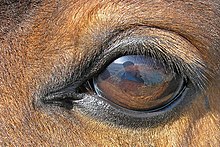Senses
See also: Equine vision
The horse's senses are generally superior to those of a human. As prey animals, they must be aware of their surroundings at all times.[55] They have the largest eyes of any land mammal,[56] and are lateral-eyed, meaning that their eyes are positioned on the sides of their heads.[57] This means that horses have a range of vision of more than 350°, with approximately 65° of this being binocular vision and the remaining 285° monocular vision.[56] Horses have excellent day and night vision, but they have two-color, or dichromatic vision; their color vision is somewhat like red-green color blindness in humans, where certain colors, especially red and related colors, appear more green.[58]Their hearing is good,[55] and the pinna of each ear can rotate up to 180°, giving the potential for 360° hearing without having to move the head.[59] Their sense of smell, while much better than that of humans, is not their strongest asset; they rely to a greater extent on vision.[55]
Horses have a great sense of balance, due partly to their ability to feel their footing and partly to highly developed proprioceptive abilities (the unconscious sense of where the body and limbs are at all times).[60] A horse's sense of touch is well developed. The most sensitive areas are around the eyes, ears, and nose.[61] Horses sense contact as subtle as an insect landing anywhere on the body.[62]
Horses have an advanced sense of taste that allows them to sort through fodder to choose what they would most like to eat,[63] and their prehensile lips can easily sort even the smallest grains. Horses generally will not eat poisonous plants. However, there are exceptions and horses will occasionally eat toxic amounts of poisonous plants even when there is adequate healthy food.[64]
Movement
All horses move naturally with four basic gaits: the four-beat walk, which averages 6.4 kilometres per hour (4.0 mph); the two-beat trot or jog at 13 to 19 kilometres per hour (8.1 to 12 mph) (faster for harness racing horses); the canter or lope, a three-beat gait that is 19 to 24 kilometres per hour (12 to 15 mph); and the gallop.[65] The gallop averages 40 to 48 kilometres per hour (25 to 30 mph),[66] but the world record for a horse galloping over a short, sprint distance is 88 kilometres per hour (55 mph).[67] Besides these basic gaits, some horses perform a two-beat pace, instead of the trot.[68] There also are several four-beat "ambling" gaits that are approximately the speed of a trot or pace, though smoother to ride. These include the lateral rack, running walk, and tölt as well as the diagonal fox trot.[69] Ambling gaits are often genetic in some breeds, known collectively as gaited horses.[70] Often, gaited horses replace the trot with one of the ambling gaits.[71]Behavior
Main articles: Horse behavior and Stable vices
Horses are prey animals with a strong fight-or-flight instinct. Their first response to threat is to startle and usually flee, although they will stand their ground and defend themselves when flight is not possible, or if their young are threatened. They also tend to be curious; when startled, they will often hesitate an instant to ascertain the cause of their fright, and may not always flee from something that they perceive as non-threatening. Most light horse riding breeds were developed for speed, agility, alertness and endurance; natural qualities that extend from their wild ancestors. However, through selective breeding, some breeds of horses are quite docile, particularly certain draft horses.[72] Horses are herd animals, with a clear hierarchy of rank, led by a dominant animal (usually a mare). They are also social creatures who are able to form companionship attachments to their own species and to other animals, including humans. They communicate in various ways, including vocalizations such as nickering or whinnying, mutual grooming, and body language. Many horses will become difficult to manage if they are isolated, but with training, horses can learn to accept a human as a companion, and thus be comfortable away from other horses.[73] However, when confined with insufficient companionship, exercise, or stimulation, individuals may develop stable vices, an assortment of bad habits, mostly psychological in origin, that include wood chewing, wall kicking, "weaving" (rocking back and forth), and other problems.[74]Intelligence and learning
In the past, horses were considered unintelligent, with no abstract thinking ability, unable to generalize, and driven primarily by a herd mentality. However, modern studies show that they perform a number of cognitive tasks on a daily basis, with mental challenges that include food procurement and social system identification. They also have good spatial discrimination abilities.[75] Studies have assessed equine intelligence in the realms of problem solving, learning speed, and knowledge retention. Results show that horses excel at simple learning, but also are able to solve advanced cognitive challenges that involve categorization and concept learning. They learn from habituation, desensitization, Pavlovian conditioning, and operant conditioning. They respond to and learn from both positive and negative reinforcement.[75] Recent studies even suggest horses are able to count if the quantity involved is less than four.[76]Domesticated horses tend to face greater mental challenges than wild horses, because they live in artificial environments that stifle instinctual behaviour while learning tasks that are not natural.[75] Horses are creatures of habit that respond and adapt well to regimentation, and respond best when the same routines and techniques are used consistently. Some trainers believe that "intelligent" horses are reflections of intelligent trainers who effectively use response conditioning techniques and positive reinforcement to train in the style that fits best with an individual animal's natural inclinations. Others who handle horses regularly note that personality also may play a role separate from intelligence in determining how a given animal responds to various experiences.[77]


Niciun comentariu:
Trimiteți un comentariu